Jagadguru’s 12 day Yatra in Karnataka
Jagadguru Shankaracharya Sri Sri Bharati Tirtha Mahaswamiji started from Sringeri on a 12-day Dharma Vijaya Yatra on the afternoon of 18th May and reached Kundapura. Received by the devotees of Kundapura Taluk, the Jagadguru was taken in a procession to the Kundeshwara Swamy temple. After Darshan of Sri Kundeshwara, the Jagadguru graced a Guru Vandana Programme.
In His Anugraha Bhashanam the Jagadguru threw light on a Vedic prayer that had just been chanted and contained the verses
अग्ने नय सुपथा राये अस्मान् … भूयिष्ठां ते नम उक्तिं विधेम
“O Lord! Many Salutations to thee! Make me go along the right path”.
The right path is the path of Dharma. While Dharma is explained in detail in Shastras, it is not possible for all to understand the nuances in Dharma. However everyone must know that the general form of Dharma and Adharma as
परोपकारः पुण्याय पापाय परपीडनम्
Know that Dharma (punya) is to help others and Adharma (paapa) is to hurt others. When the matter boils down to helping others, some feel that one cannot perform to Dharma just because one does not have money. While it is true that an ordinary person will be unable to contribute to various charitable activities including say, building a temple, people must remember that even going to a temple and offering prostrations is Dharma. People have a lot of time but waste it in unnecessary and useless activities. Instead, go to a temple and remember the Lord, chant the Lord’s names and offer prostrations. Is it difficult to chant the Lord’s names that bring out one’s Shreyas? Some may ask – we are physically challenged or weak with age, and cannot walk to the temple. The Shastras provide a way even in such scenarios – contemplate on the Lord remaining at one’s own place. However it is true that people do not get the inspiration to do even this. This inspiration has to come from the Lord. And this is the basis of the Vedic prayer.
The following morning the Jagadguru had Darshan at Sri Rama temple (Rama Kshetra Samaja), Mahakali temple (Konkana Kharvi Samaja) and blessed the devotees with Anugraha Bhashanam. The Jagadguru then graced the Poornahuti of Rudra Homa at Kundeshwara temple.

Jagadguru Perfmring Prathishta Kumbhabhisheka
at Kenda Mahasati temple.
On 19th evening, the Jagadguru graced the Durga Parameshwari temple and Kutumeshwara temple, Bhatkal and then reached Manki near Honnavar, where a welcome procession took place organised by by the fishermen folk of the Konkana Kharvi Samaja. In the Guru Vandana programme organised by the Samaja, the Jagadguru rendered an Anugraha Bhashanam stressing the need for faith in God and Guru. Some people feel that they have everything – education, money, power, a big following ready to do their bidding. However none of these are permanent. Faith in God and Guru if cultivated are permanent. Who gave shelter to Draupadi and to Vibhishana in difficult times? The Lord shows no partiality to anyone. Can it be said that a river is partial? Anyone who goes to it can get water. The Lord does not look at scholarship, wealth or age but only devotion. One should also serve the society. When we secure a lot from society, should we not be grateful to the society and serve it. Our Sanatana Dharma has two tenets common to all – faith in God and help people in need.
On the morning of 20th May, the Jagadguru performed the Punah Prathishta of Goddess Kenda Mahasati temple, Manki. It was a moment of great joy for the members of the Samaja who had completed the temple construction and had awaited the auspicious moment for the Jagadguru to consecrate the Goddess.
On 20th evening, the Jagadguru was reverentially welcomed to Honnavar by Sri Sadyojat Shankarashrama Swamiji (Chitrapur Math, Shirali), Sri Vamanashrama Swamiji (Shantashram Math, Haladipur), Sri Sacchidananda Jnaneshwara Bharati Swamiji (Davaijna Math, Karki) and Sri Balakrishnananda Saraswati Swamiji, Nanjangud. The Devotees of Honnavar Taluk had organised a public function that was graced by the Jagadguru along with the Mathadhipatis.
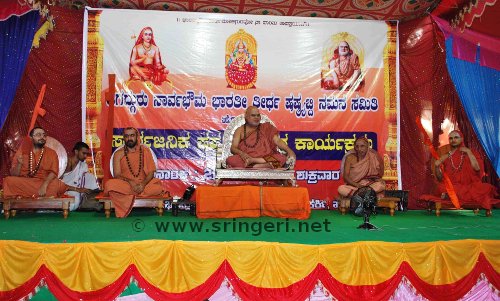
Honnavara Arrival Sabha – Jagadguru with Mathadhipatis of Karki, Chitrapur and Haladipur
The Jagadguru in His Anugraha Bhashanam said that Dharma is central to the followers of Sanatana Dharma. However there are people who do come to Me and say – ‘Kindly establish a new Dharma Shastra as we are unable to follow the rules that exist.’ Adi Shankaracharya did not establish the Peetham for its Peethadhipatis to redefine Dharma Shastra. The duty of the Peethadhipatis is to ensure that people follow what exist in the Dharma Shastras. The Dharma Shastras exist to show us the path of Shreyas. The writers of the Dharma Shastras stand to gain nothing out of it. They had already fulfilled the purpose of their lives and it is for our own betterment that the Shastras exist.
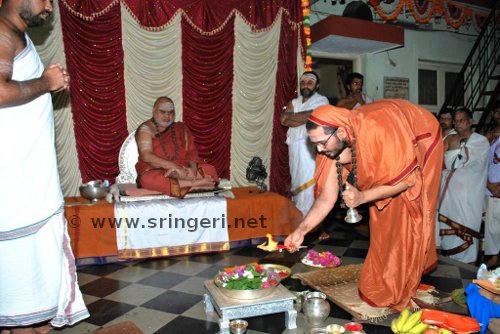
Mathadhipati of Daivajna Math, Karki offering Pada Puja to the Jagadguru
The Jagadguru then reached Shantashram Math, Haladipur where He was received by Sri Vamanashrama Swamiji and performed Chandramoulishwara Puja there. On the morning of May 21st, the Jagadguru graced the Daivajna Math in Karki Math. Sri Sacchidananda Jnaneshwara Bharati Swamiji performed Dhuli Pada Puja. In His Anugraha Bhashanam, the Jagadguru stressed the importance of Guru Bhakti and explained about the Gurvashtakam of Adi Shankaracharya. Adi Shankaracharya’s life in itself is an exemplar of Guru Bhakti as can be observed during His stay with Guru Govinda Bhagavatpada and His meeting with Paramaguru Gaudapada.
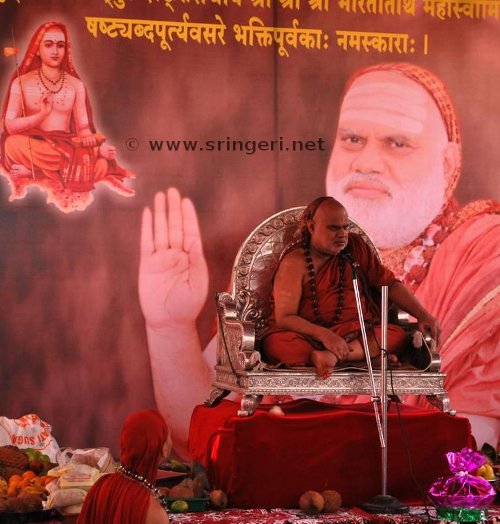
Jagadguru’s Anugraha Bhashanam at Shantashram Math, Haladipur (also seen is Sri Vamanashrama Swamiji of the Math)
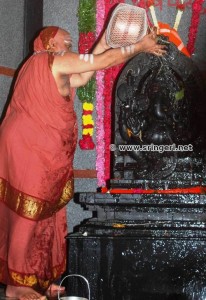
Jagadguru performing Prathishta Puja
of Sri Ganapati at Karwar
After having Darshan at the ancient Durga temple in Honnavara, the Jagadguru reached the Shantashram Math, where Dhuli Pada Puja was performed by Sri Vamanashrama Swamiji. In His Anugraha Bhashanam, the Jagadguru reminded the devotees of the importance of Guru Bhakti through the illustration Sri Adi Shankaracharya’s devoted disciple Giri. Giri, initially a dullard, became blessed with all knowledge owing to the power of his Guru Bhakti. Famous for the compilation of the Totakashtakam in praise of Sri Adi Shankaracharya, he came to be called as Totakacharya and has even penned a Vedantic text named Shruti-saara-samuddharanam.
Starting from Haladipur in the evening, the Jagadguru graced the Sharada Sahakari Bank (at Ankola) and Durgamba temple en route to Karwar. The following day (May 22nd), the Jagadguru performed the Kumbhabhisheka of the Ganapati temple at Karwar and rendered an Anugraha Bhashanam in the evening at the Municipal Garden.
On the afternoon of 23rd, enroute to Shirali, the Jagadguru inaugurated with His lotus hands a Sabha Bhavanam of the Deevatige Samaja in Bhatkal Taluk. In His Anugraha Bhashanam, the Jagadguru mentioned that the means to leading a pure life and true happiness is threefold – Performing one’s duty, having faith in God and remaining satisfied with what one has.
On 23rd evening, the Jagadguru reached Shirali and was welcomed to Chitrapur Math by Sri Sadyojata Shankarashrama Swamiji. The following morning the Jagadguru graced the Goshala of the Chitrapur Math. Reaching Mangalore on 24th evening, the Jagadguru graced the Guru Vandana Programme at the Sringeri Shankara Math at Kotekar, Mangalore. On May25th and 26th, the Poornahutis of the Rudra Homa and Chandi Homa took place respectively in the Jagadguru’s divine presence. In His Anugraha Bhashanam delivered on the evening of 25th May, the Jagadguru explained the significance of the Shastras and Dharma.
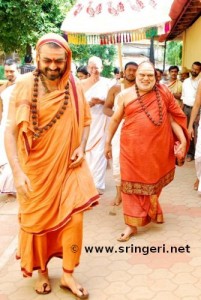
Jagadguru being welcomed to the Goshala of Chitrapur
Math by Sri Sadyojata Shankarashrama Swamiji
शास्तीति शास्त्रम्
that which ordains is Shastra and that the Vedas are the Lord’s commands (“shruti smriti mamaivaajne” – the Shrutis and Smritis are My commands). For instance, the Shastras direct that one must follow Ahimsa and speaking the truth. Adhering to these directives constitute Dharma and is indicative of protecting Dharma.
On May 26th, the Jagadguru’s camp proceeded to the abode of Goddess Annapoorna at Horanadu. At the request of the temple authorities and devotees, an Adda Pallaki Utsava was conducted with the Jagadguru being welcomed on the golden palanquin. Sri Bhimeshwara Joshi , administrative officer of the temple, mentioned that the Punah Prathishta of Goddess Annapoorni had been done by Jagadguru Sri Abhinava Vidyatirtha Mahaswamiji in 1973.
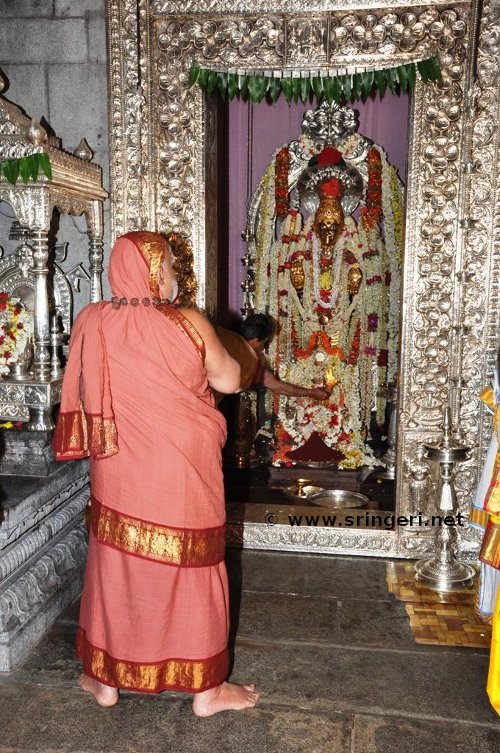
Jagadguru at the shrine of Goddess Annapoorni, Horanadu
At that time, the Horanadu Srikshetra had honoured the Jagadguru by welcoming Him with an Adda Pallakki Utsava. It may be remembered that about 21 years ago, the Kumbhabhisheka of the Navagraha deities at the temple of Goddess Annapoorni had been performed by Jagadguru Sri Bharati Tirtha Mahaswamiji. The present occasion turned out to be one in which the Jagadguru was honoured with the Adda Pallakki Utsava, and the Punah-Prathishta Kumbhabhisheka of the Navagraha deities through the lotus hands of the Jagadguru taking place the following day. The Jagadguru also offered an elaborate worship to Goddess Annapoorna.
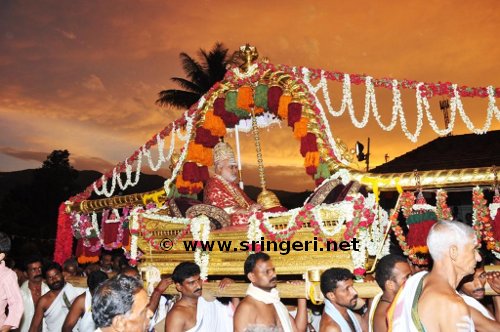
Adda Pallaki Utsava of the Jagadguru at Horanadu
On the evening of the 27th, the Jagadguru reached the sacred town of Kalasa, famous as Dakshina Kashi. The next morning, the Jagadguru performed Pooja, Kumbhabhisheka and a Samarpanam of Mukhawada to Lord Kalaseshwara. In His Anugraha Bhashanam, the Jagadguru pointed out that Sanatana Dharma rests on faith in God and His worship with Trikarana shuddhi (body, mind and speech). This is reflected in the innumerable temples that exist in the country.
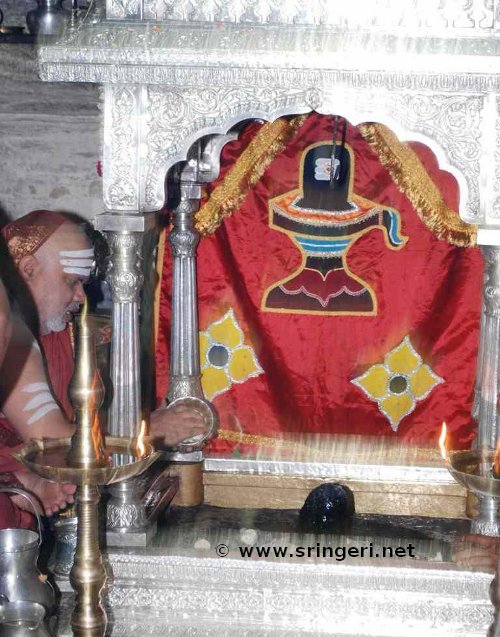
Jagadguru worshipping Lord Kalaseshwara, Kalasa
From Kalasa, the Jagadguru reached the town of Jayapura, neighboring Sringeri. It was about 43 years ago, that Jagadguru Sri Abhinava Vidyatirtha Mahaswamiji had graced Jayapura for a couple of days and eventhough Jagadguru Sri Bharati Tirtha Mahaswamiji had come to Jayapura, He had not camped there and performed the Sharada Chandramoulishwara Puja. The devotees expressed joy that this was made possible on the occasion. In His Anugraha Bhashanam, the Jagadguru mentioned Dharma alone accompanies us even after death of the physical body and becomes cause for happiness. The Lord has explained various tenets of Dharma in the Bhagavad Gita – that one must try and practice the ideal that involves mutual respect and love towards all beings. It is more fruitful to engage in fully focused worship even if only for a few minutes than to perform an elaborate worship for hours during which the mind keeps wandering. The Jagadguru also made special mention of Sri S N Krishnamurthy (the personal assistant to the Jagadguru and hailing from Jayapura) saying that it was a matter of pride for Jayapura that one of its citizens has been serving the Jagadguru for 30 years with total devotion and dedication to Guru Seva. The following morning, the Jagadguru worshipped at the Durga temple in Jayapura.
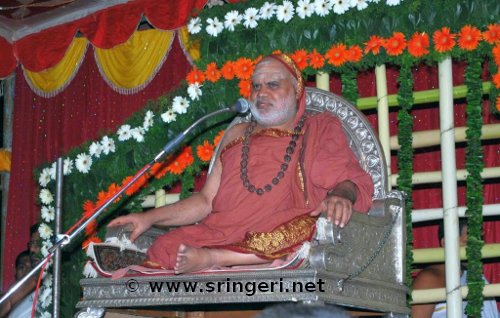
Jagadguru rendering Anugraha Bhashanam at Jayapura
The Jagadguru reached Sagara on May 29th and the following day, inaugurated the a Sabha Bhavanam named after Shankaracharya for conducting Upanyasas in the premises of the Sringeri Shankara Math at Sagara. The Jagadguru returned to Sringeri on the evening of May 30th.
